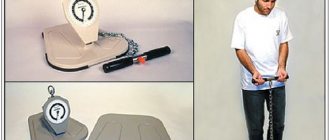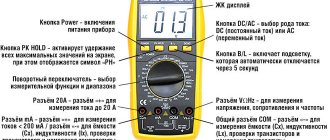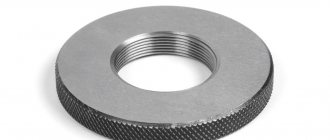- How is strength measured?
Force:
When studying natural phenomena, different physical quantities are used. In order to describe qualitatively and quantitatively the interaction of bodies, a physical quantity is introduced, which is called force.
What is a dynamometer?
The device determines the relative power of available or required effort to perform any physical action.
Industrial, medical and consumer devices differ:
- dimensions;
- principle of operation;
- calculation method;
- scale type;
- technical parameters and other characteristics.
A dynamometer is used to measure the strength of a person, unit, machine, etc. The designs and types of such devices vary over a wide technical range. In the International System of Units, force is measured in newtons. Dynamometers, depending on their purpose, are equipped with different scales. Some devices measure the force applied in kilograms. It is common European practice to define force in newtons.
It reflects the amount required for 1 second. change the speed of movement of a solid object weighing 1 kg. This indicator is calculated by the computational link of the dynamometer. Most models for household, industrial and medical purposes use decanewtons or kilograms, which is necessary to unify the obtained values. Newtons are used only in some laboratory and educational dynamometers.
Vector and scalar quantities
A vector quantity (for example, a force applied to a body), in addition to its value (modulus), is also characterized by direction. A scalar quantity (for example, length) is characterized only by its value. All classical laws of mechanics are formulated for vector quantities.
Picture 1.
In Fig. Figure 1 shows various options for the location of the vector ${ \large \overrightarrow{F}}$ and its projections ${ \large F_x}$ and ${ \large F_y}$ on the axis ${ \large X}$ and ${ \large Y }$ accordingly:
- A. the quantities ${ \large F_x}$ and ${ \large F_y}$ are non-zero and positive
- B. the quantities ${\large F_x}$ and ${\large F_y}$ are non-zero, while ${\large F_y}$ is a positive quantity and ${\large F_x}$ is negative, because the vector ${\large \overrightarrow{F}}$ is directed in the direction opposite to the direction of the ${\large X}$ axis
- C. ${\large F_y}$ is a positive non-zero quantity, ${\large F_x}$ is equal to zero, because the vector ${\large \overrightarrow{F}}$ is directed perpendicular to the ${\large X}$ axis
Purpose
Compact devices and stationary equipment have different areas of application. Regardless of the technical modification, dimensions and design of the measuring element, all such devices are designed to determine the applied force.
In construction, a dynamometer is used to measure the degree of pressure on the holding frame:
- vertically suspended load;
- concrete slabs;
- various floors;
- external elements of buildings;
- balconies;
- flights of stairs.
Such large-sized equipment is used in the mining industry to determine the force required to destroy rock using a non-explosive method. In industrial production, stationary dynamometers are used to calculate the strength of materials and structures.
Electronic devices that are used in medicine to determine the physiological parameters of muscle fibers are highly accurate. Such devices measure the power indicators of critical components, mechanisms and assemblies.
Industrial Application
In the metalworking industry, similar equipment is used to determine the functional characteristics of press dies. Dynamometers make it possible to determine with relative accuracy the cutting, bending and deformation forces of metal workpieces and products.
One of the purposes of industrial-type devices is to measure the traction capacity of production plants and torque, which are indicated in the technical data sheet of vehicles, engines and other units.
Dynamometers of different types are used in the manufacture of:
- robotic mechanisms;
- space technology;
- military vehicles and installations;
- prostheses;
- implants;
- heat and electric locomotives;
- electronic and analog scales;
- control and measuring equipment for various purposes;
- power units;
- turbines;
- lifting and rigging devices.
Such devices are used in the production of torque wrenches designed for tightening threaded fasteners with a given force. Dynamometers are needed in the production of agricultural and municipal machinery, mining dump trucks and heavy installation equipment.
In construction
Devices and equipment for measuring force are used in the construction of residential complexes and administrative buildings. They are necessary when designing overpasses and transport interchanges.
Dynamometers are designed to measure the load-bearing capacity of building structures, beams and architectural fragments. Such equipment is used in the construction of dams and other hydraulic structures. They have found application in bridge construction, design of Ferris wheels and amusement rides.
In medicine
Any physiological and anatomical parameter of the human body can be accurately assessed in digital terms. For this purpose, specialized medical devices are used.
The dynamometer is used to measure muscle strength and muscle contractions. Devices for medical purposes have a wrist or postural design. There are optical dynamometers that are used to determine the strength of the muscle fibers that support the eye lens.
The use of such monitoring and measuring equipment for medical purposes allows you to accurately:
- Establish the patient's physical condition.
- Determine the speed of recovery after exhaustion, serious illness or injury.
- Assess the dynamics of postoperative rehabilitation.
- Calculate muscle functionality.
- To find out the degree of muscle development in patients with birth defects and genetic pathologies.
Indicators of muscle strength provided by a medical dynamometer vary within a certain range depending on the degree of fatigue of the subject, his age, and gender. Using a dynamometer, the strength of the handshake is determined, which, according to recent scientific data, can be used to determine the functional state of the heart apparatus and predict the risk of an acute cardiac crisis.
An important medical purpose of the device is to assess children's health. Scientists from Baylor University (Texas, USA) found that the functional state of a child’s body can be determined by the strength of the hand’s grip. There is evidence of a relationship between muscle weakness and life expectancy. To determine this parameter, such a measuring device is used.
Superposition principle
Experience shows that if several other bodies act on a given body, then the corresponding forces add up as vectors. More precisely, the principle of superposition is valid. The principle of superposition of forces. Let the forces ${\large \overrightarrow{F_1}, \overrightarrow{F_2},\ \ldots \overrightarrow{F_n}}$ act on the body. If we replace them with one force ${\large \overrightarrow{F} = \overrightarrow{F_1 } + \overrightarrow{F_2} \ldots + \overrightarrow{F_n}}$, then the result of the impact will not change. The force ${\large \overrightarrow{F}}$ is called the resultant of the forces ${\large \overrightarrow{F_1}, \overrightarrow{F_2},\ \ldots \overrightarrow{F_n}}$ or the resultant force.
Types of dynamometers
In accordance with the design of the power unit and the implemented operating principle, electronic, hydraulic and mechanical devices are distinguished. The latter are further divided into spring and lever. There are combined models that combine several operating principles to ensure high accuracy of measurements for various purposes. A special category of dynamometers are diagnostic devices that have their own classification.
Some models are intended exclusively for use in medical institutions, hospitals and physiotherapy offices. There are compact household dynamometers.
The range of such devices is varied and includes dozens of manual options. There are specific devices for single use, called disposable sensors.
They are used to determine the strength of destructive loads - powerful explosions, extreme dynamic pressure, colossal impacts. Before losing integrity and failing, they manage to transmit a signal to a receiving unit located at a safe distance about the characteristics of the destructive impact.
Mechanical models
The simplest and most unpretentious products to use. In a spring-type mechanical dynamometer, the applied force is transferred to a spirally twisted steel wire. Depending on the design features and purpose of the device, the working element is subjected to tension or compression. The recorded indicator of elastic deformation is recorded by the arrow of the measuring scale. The result is considered proportional to the mechanical force.
Dynamometers with a lever instead of a spring are no less common. It is attached to the needle of the measuring scale. The acting force deflects the lever rod or plate by a certain number of units. The recorded value is considered to be indicative of the applied mechanical pressure. Such dynamometers cannot be called very precise measuring instruments.
The simplest and well-known stretching instrument is the cantar or steelyard. This is a manual scale with a spring design. A common example of a lever tool for household use is a torque wrench for cars.
Hydraulic modifications
Devices of this type measure the force of an external influence by moving (pushing) a liquid contained in a special flask. The displaced substance moves through the pipe onto a scale that records its level. A dynamometer is used to measure torque in turboprop engines. Hydraulic models are installed in aircraft equipment for automated feathering of the propeller in the event of a power plant failure.
Such devices are much more accurate than their mechanical counterparts, but have a more complex design. Depressurization of the cylinder with liquid instantly leads to loss of functionality of the device.
Errors in dosage when filling a hydraulic dynamometer have a significant impact on the performance of the device and the accuracy of calculations. In aviation technology, devices are used that are made in the form of several cylinders from a high-strength and heat-resistant composite or metal alloy.
Electronic dynamometers
The design contains a pair of sensors for different purposes. One, considered the main one, converts deformation energy into an electrical impulse. An auxiliary sensor is needed to amplify the signal and record it in RAM.
The electronic unit is:
- inductive;
- piezoelectric;
- vibration-frequency;
- capacitor;
- strain gauge.
Such devices are extremely accurate and maintain synchronization with additional equipment - mechanisms for determining cutting force or wire devices that are used to evaluate resistance. Electronic dynamometers are equipped with a small display and a touch or keypad control panel. The calculated result is displayed as a numerical value and in the form of an oscillogram.
Reference models
This category includes electronic devices with particularly precise calibration. They are used in laboratory practice, for setting up other dynamometers, and on test benches. Reference devices are designed for testing critical components, assemblies and mechanisms. This dynamometer has a force sensor connected to a digital measuring unit. The performance of exemplary models is not affected by environmental conditions.
They are equipped with an integrated self-diagnosis mechanism. Such devices have the function of automatically compensating for lateral loads, preventing them from distorting the value displayed on the display. The dynamometer, which is given the name reference, is used to measure strength indicators with maximum accuracy. Such devices have compact dimensions, resistance to external factors and durability.
They have a user interface, a variety of digital indicators and a port for connecting to a computer. Reference models are compatible with other types of control and measuring equipment, which allows for a comprehensive assessment of the operating parameters of the tested mechanisms and products.
Medical dynamometers
Highly specialized devices designed to test the physiological parameters of the body, performance and endurance of people. Such dynamometers are used in clinical practice and sports medicine. Existing models are wrist and backbone. The former are diagnostic devices for determining the compressive capacity of the upper limbs.
Devices of this class are used to assess the condition or monitor professional suitability in:
- physiotherapy practice;
- sports;
- Ministry of Emergency Situations;
- military units;
- law enforcement agencies;
- companies providing forwarding services;
- transport enterprises.
A separate group consists of children's hand dynamometers. The most common domestic model in this category is DMER-30-0.5. Milling devices have great functionality. They are intended to test the strength of different muscle groups responsible for straightening the body, maintaining balance and stabilizing the spinal column. The most popular model of deadlift dynamometers is DS-500.
Center of mass
The point of the center of mass is remarkable in that if a great many forces act on the particles forming a body (no matter whether it is solid or liquid, a cluster of stars or something else) (meaning only external forces, since all internal forces compensate each other), then the resulting the force leads to such an acceleration of this point as if the entire mass of the body ${\large m}$ were in it.
The position of the center of mass is determined by the equation:
${\large R_{cm} = \frac{\sum m_i\, r_i}{\sum m_i}}$
This is a vector equation, i.e. in fact, three equations - one for each of the three directions. But consider only the ${\large x}$ direction. What does the following equality mean?
${\large X_{cm} = \frac{\sum m_i\, x_i}{\sum m_i}}$
Suppose the body is divided into small pieces with the same mass ${\large m}$, and the total mass of the body will be equal to the number of such pieces ${\large N}$ multiplied by the mass of one piece, for example 1 gram. Then this equation means that you need to take the ${\large x}$ coordinates of all the pieces, add them up and divide the result by the number of pieces. In other words, if the masses of the pieces are equal, then ${\large X_{cm}}$ will be simply the arithmetic mean of the ${\large x}$ coordinates of all the pieces.
| center of mass of a complex body lies on the line connecting the centers of mass its two constituent parts |
Why is it necessary to know strength indicators?
Such devices have virtually unlimited applications. Manufacturers of various equipment indicate the results obtained with their help in technical documentation. Measuring power and load capabilities allows you to predict the service life and determine the operational life of a machine, component or unit. On this basis, rules for the use of products and their service are established.
The data obtained using dynamometers is used in engineering calculations and design work. Such information is of key importance during the construction of buildings and bridges, hydraulic engineering and other structures. Using established strength indicators and load capacities, they ensure the safety of road traffic, manned flights, operation of mechanisms and equipment, and park attractions.
In medicine, data obtained using such devices is necessary for choosing therapeutic tactics, methods and means of rehabilitation. For professional athletes, dynamometer analysis allows them to evaluate the effectiveness of training and make the necessary adjustments to accelerate progress.
Newton's second and third laws
The interaction of bodies can be described using the concept of force. Force is a vector quantity that is a measure of the influence of one body on another. Being a vector, force is characterized by its modulus (absolute value) and direction in space. In addition, the point of application of the force is important: the same force in magnitude and direction, applied at different points of the body, can have different effects. So, if you grab the rim of a bicycle wheel and pull tangentially to the rim, the wheel will begin to rotate. If you pull along the radius, there will be no rotation.
Newton's second law
The product of the body mass and the acceleration vector is the resultant of all forces applied to the body:
${\large m \cdot \overrightarrow{a} = \overrightarrow{F} }$
Newton's second law relates acceleration and force vectors. This means that the following statements are true.
- ${\large m \cdot a = F}$, where ${\large a}$ is the acceleration modulus, ${\large F}$ is the resulting force modulus.
- The acceleration vector has the same direction as the resultant force vector, since the mass of the body is positive.
Newton's third law
Two bodies act on each other with forces equal in magnitude and opposite in direction. These forces have the same physical nature and are directed along a straight line connecting their points of application.
Factors that influence strength performance
Electronic devices are considered the most accurate. Their measurements are virtually unaffected by environmental factors. The results of medical examinations are influenced by the time of day and the patient’s physical fitness. The lowest muscle strength is recorded in the morning and evening hours. At midday, this physiological indicator reaches its peak value.
The amount of muscle strength is affected by the psycho-emotional state at the time of the test. Sleep disorder, nutrient deficiency in the body, vitamin and oxygen starvation reduce muscle activity and reduce the indicators obtained by measuring with such a device. Mechanical dynamometers are considered the least accurate.
The level of error in calculations of such devices is influenced by a large number of external and design factors:
- ambient temperature;
- air humidity and density;
- degree of wear of parts;
- backlashes;
- build quality;
- power block manufacturing material;
- spring properties of steel, which change during operation.
A dynamometer is used to measure the strength capabilities of a mechanism, building structure or human body. In the latter case, the obtained values decrease with insufficient physical activity and muscular dystrophy.
Description of KINGTONY 34855 devices
The presented dynamometer is made with two holders. The spring in this case is used with great strength. The dial is applied with 0.2 mN divisions. The overload protection system is first class. The case is of a moisture-resistant type. The maximum overload allowed is 13 N.
Fastening for installation is included as standard. If you believe customer reviews, this dynamometer is not afraid of sub-zero temperatures. The measurement accuracy of the device is at 0.6%. The modification is not best suited for laboratory experiments. You can buy these devices for measuring force for 65 thousand rubles.
Operating principle of a dynamometer
Mechanical models are considered the simplest in design and operating principle. In spring modifications, a force to be measured is applied to the elastic part. It causes deformation changes - stretching or compression. This activates a pointer attached to the spring, which moves along the scale, recording the amount of force applied. Lever and hydraulic dynamometers have a similar operating principle.
In the latter, the role of a deformable element and, at the same time, a recording device is played by a liquid pushed out by the applied force. In lever models, a moving part changes position under external pressure. The lever moves the arrow attached to it by a certain number of scale divisions. Due to their accuracy and versatility, strain gauge devices have become widespread.
Such devices are capable of recording dynamic and static loads. Its design includes a measuring element of increased elasticity and several strain gauge grids. The applied force causes deformation changes, which lead to an imbalance of the resistance bridge currents. As a result, an electrical impulse is generated, captured by a special sensor and displayed on the display as a digital value.
Induction models, designed for testing power units with power up to 966 hp, are distinguished by a fundamentally different mechanism of action and low inertia. The design of such devices includes a polished metal disk that is influenced by electromagnetic forces. It turns around at a set speed, generating current vortices, the magnitude of which is recorded by a tensor sensor.
The dynamometer is used to measure static load indicators. For this purpose, devices with a piezoelectric operating principle are used. The structural structure of such devices includes a special plate.
It is based on quartz with defect-free areas. The mineral has a direct or inverse piezoelectric effect. A charge is formed by mechanical action on a quartz plate. The type of electrical reaction is determined by the position of the cut relative to the axial lines of the crystals. A special converter transforms the charge into voltage. Devices of this class are used to assess the impact power.
To measure pressure during grinding, milling and other types of metalworking, control tools with a wire indicator are used. Their design includes a square plate made of a durable and elastic alloy. It is attached to the inner surface of the case with spring links made of a special grade of steel. The device allows you to measure horizontal and radial force with high accuracy.
The pressure exerted on the plate is recorded by the reading unit, which displays it on the display. The sensor accurately captures the vibration pattern of the part on the elastic fasteners and converts them into digital values.
Hydraulic devices
Hydraulic dynamometers have many advantages. First of all, it is important to note the simplicity of the design. The hydraulic mechanism is located under the handle on models. Holders are often used in a curved shape. These devices are well suited for hospitals. However, they are rarely used for laboratory experiments. First of all, it is important to note that they are afraid of high temperatures. The maximum load parameter is on average 4.5 N. At high humidity, hydraulic devices should not be used.
Specifications
They depend on the type, functionality and scope of application of the device. The most common domestic models of dynamometers are the DK series.
These simple, but accurate and reliable mechanical devices have the following technical characteristics:
| Parameter | Meaning |
| Calculation range | 3-140 decanewtons (daN) |
| Level of error | 0.75-4 daN |
| Scale pitch | 0.5-2 daN |
| Weight | 170-250 g |
Electronic copies are more diverse and functional. They have an extended range of measured indicators - 2-120 decanewtons. The discreteness (level of error) for most of these devices does not exceed 0.5 daN. Electronic dynamometers automatically turn off after a time specified in the settings if there is no user activity. They can withstand temperatures of +10...+35°C without errors in calculations.
Medical diagnostic equipment of the stand type has a maximum value of up to 500 decanewtons. Such devices are equipped with a large scale with a division value of 2-5 daN. Such devices make it possible to diagnose early manifestations of scoliosis and postural disorders in children.
Heavier - Lighter
The weight of a body ${\large P}$ is expressed by the product of its mass ${\large m}$ and the gravitational acceleration ${\large g}$.
${\large P = m \cdot g}$
When on earth a body becomes lighter (presses less on the scales), this is due to a decrease in mass. On the moon, everything is different; the decrease in weight is caused by a change in another factor - ${\large g}$, since the acceleration of gravity on the surface of the moon is six times less than on the earth.
mass of the earth = ${\large 5.9736 \cdot {10^{24}}\ kg }$
moon mass = ${\large 7.3477 \cdot {10^{22}}\ kg }$
acceleration of gravity on Earth = ${\large 9.81\ m / c^2 }$
gravitational acceleration on the Moon = ${\large 1.62 \ m / c^2 }$
As a result, the product ${\large m \cdot g }$, and therefore the weight, decreases by 6 times.
But it is impossible to describe both of these phenomena with the same expression “make it easier.” On the moon, bodies do not become lighter, but only fall less rapidly; they are “less epileptic”))).
Dynamometer in everyday life
With a steelyard you can quickly measure the weight of hand luggage, household items and food products. Despite the advent of high-precision electronic scales, cheap and convenient pocket dynamometers are still actively used in everyday life.
More structurally complex devices in everyday life are used to measure the force of closing elevator doors and passenger transport:
- buses;
- trolleybuses;
- trams;
- subway cars.
There are home instruments designed to assess the degree of ripeness of fruits. The operation of the tonometer is based on the dynamometer principle. Such a device will be needed if it is necessary to find out the weight of substances in different states - liquid, bulk, dry.
Dynamometers are useful when performing installation and construction work and apartment renovation. They are used to evaluate the lifting force of car windows. Mechanical devices are used in everyday life to measure the closing force of hatches and sliding garage doors.
Description of DK-158 devices
This is a professional and multifunctional dynamometer. The model is not the best for measuring grip strength. It supports all major units of measurement. If desired, the software can be changed. The interface is provided by the manufacturer for the C203 series. In total, the dynamometer of this series uses three adapters. The device does not support memory cards. The first class overload protection system is used. If desired, you can connect scales. The switching speed is 1.3 seconds.
The graphic display is provided with bright backlight. There is a function for saving measurement results. The battery used to operate the device is lithium type. Its conductivity parameter is 3.3 microns. The battery life is a maximum of 12 hours. If necessary, the dynamometer can be put into sleep mode to save battery power. These devices for measuring force cost about 46 thousand rubles.










